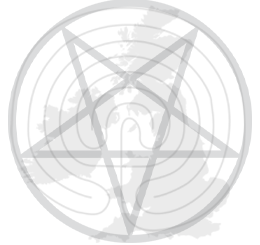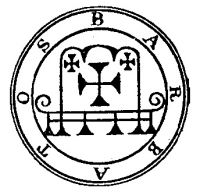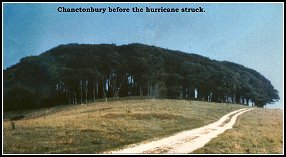The Golden Dawn
The Hermetic Order of the Golden Dawn was the most influential occult group to emerge from the end of the nineteenth century occult revival. The main achievement of the group, and of its more influential individuals, was to create a working system of magic, bonded from the various separate strands of tradition in existence at the time.
The group was founded in the year 1888 by William Wynn Westcott (1848-1925), a doctor, and a Freemason, William Robert Woodman, also a doctor and a mason, and Samuel Liddell MacGregor Mathers (1854-1918), who was also a mason.
The order claimed its pedigree from coded documents in Dr Wynn Westcott’s possession; these claimed the group was a branch of a German Rosicrucian Order. They outlined five Masonic rituals, which were expanded upon by Mathers. It is highly likely that these papers were forged by Westcott, and it was this accusation that later led to the break up of the order.
 The prime mover of the Golden Dawn turned out to be Samuel Liddell MacGregor Mathers. He was responsible in main for the cohesion the Golden Dawns structure, rituals, and whole system of magic. Mathers, who was also a mason, was a flamboyant character with a romantic leaning to all things Celtic. He changed his name to incorporate the MacGregor, and claimed descendance from the Scottish Clan. It was his confidence and charm that lead to the orders great popularity among society at that time.
The prime mover of the Golden Dawn turned out to be Samuel Liddell MacGregor Mathers. He was responsible in main for the cohesion the Golden Dawns structure, rituals, and whole system of magic. Mathers, who was also a mason, was a flamboyant character with a romantic leaning to all things Celtic. He changed his name to incorporate the MacGregor, and claimed descendance from the Scottish Clan. It was his confidence and charm that lead to the orders great popularity among society at that time.
Like many other members of the Golden Dawn, he had a passion for reworking and translating some of the Medieval Grimoires, and a great deal of his time was spent researching in the British Library. Mathers wrote much of the Golden Dawn’s material, he drew on information gleaned from his long researches into old magical texts. He used Eliphas Levi’s system of magic, along with Egyptian magic, Graeco-Egyptian magic, and Jewish magic, fused with ideas from medieval grimoires, the Tarot and Eastern mysticism. Dee’s strange Enochain language was also incorporated in places. This mass of varied material allowed them to say that their tradition stretched all the way back through the ages to Egypt, land of magic and mystery. The fact that Mathers managed to fuse all of this material into a working coherent system is his great legacy.
The hierarchical structure of the Golden Dawn was divided into ten degrees, based on the ten degrees of the Sephiroth from the Qabalah (Kabbalah). Members passed through each of the levels by sitting exams and partaking in theatrical ritual. The rituals took place in specially designed temples named after the Egyptian gods.
The main emphasis and motive of passing through the degrees was to develop the personality through the higher self, and achieve god like status by identifying with universal energies and archetypes.
These energies were seen as already present within the human psyche, they just needed to be brought to the surface and controlled with the force of the will and imagination.
As with many occult groups, the leading members, Mathers in particular, claimed that they were in contact with a secret order of higher intelligences or Magi. These beings guided the working material and controlled how the order developed. The secret order were unapproachable, which was a useful barrier to detractors.
The Golden Dawn had some very influential people within its ranks. W. B. Yeats, Aleister Crowley, Constance Wilde, Algernon Blackwood, Arthur Machen, A. E. Waite, Annie Horniman, Florence Farr, Gerald Kelly and Maude Gonne were all members. There was also a rumour that Wallace Budge, who was in charge of Egyptology at the British Museum, was also involved, although this has never been verified.
By the year 1900 the inflated egos of many of the group members had caused arguments, and created schisms within the group. Aleister Crowley (who joined in 1898) had a major part in this. He was not well liked, but he sided with Mathers (although they were later to have a magical battle of their own), Mathers accused Wynn Wescott of faking the Rosicrucian documents on which the Golden Dawn was founded. It seems now that the allegation was probably true, but this undermining of the orders foundations did not go down well, and Mathers was expelled.
Mathers left England for Paris with his wife Moina in 1892. While in Paris he founded a splinter group of the Golden Dawn, but the order was never as powerful as it had been in Britain. Mathers died in Paris in 1918.William Butler Yeats, the Irish poet (who joined in 1890 from the Theosophical Society) took over the Golden Dawn Core group after Mather’s departure, but it was A. E. Waite, gaining control in 1903 who took the order down a different path. He changed the name to The Holy Order of the Golden Dawn, and pushed the order towards more Christian leanings. He finally closed the Order down around 1914 because of apathy, and dwindling membership.
By the time the core of the Golden Dawn had fizzled out there were temples as far apart as Bradford and Paris. There were also groups in Weston Super Mare, Edinburgh and Chicago. Many occult groups now claim descent from the Golden Dawn, and its advancement of the Western Mystery Tradition cannot be underestimated.

![The original uploader was Ihcoyc at English Wikipedia. [Public domain], via Wikimedia Commons](http://www.mysteriousbritain.co.uk/wp/wp-content/uploads/2008/09/Samuel_Liddell_MacGregor_Mathers_in_Egyptian_getup-237x300.jpg)



Re: The Golden Dawn
it is indeed a fantastic group.but may i know where your temple is located in nigeria.